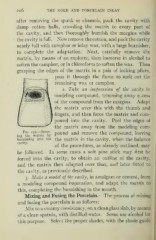Page 238 - My FlipBook
P. 238
206 THE GOLD AND PORCELAIN LNLAY
after removing the spunk or chamois, pack the cavity with
damp cotton balls, crowding the matrix to every part of
the cavity, and then thoroughly burnish the margins while
the cavity is full. Now remove the cotton, and pack the cavity
nearly full with camphor or inlay wax, with a large burnisher,
to complete the adaptation. Next, carefully remove the
matrix, by means of an explorer, then immerse in alcohol to
soften the camphor, or in chloroform to soften the wax. Then
grasping the edges of the matrix in a pair of locking pliers,
pass it through the flame to melt out the
remaining wax or camphor.
2. Take an impression of the caiity in
modeling compound, trimming away e.^cess
of the compound from the margins. Adapt
the matrix over this with the thumb and
fingers, and then force the matrix and com-
pound into the cavity. Peel the edges of
the matrix away from the modeling com-
tr^yrtiiirtii-iiriiiri
"^th ^matrfx^^by P^^^^
• and rcmovc the compound, leaving
burnishing into the the matrix in the cavity, when the balance
of the procedures, as already outlined, may
be followed. In some cases a soft pine stick may first be
forced into the cavity, to obtain an outline of the cavity,
and the matrix then adapted over that, and later fitted to
the cavity, as previously described.
3. Make a model of the cavity, in amalgam or cement, from
a modeling compound impression, and adapt the matrix to
this, completing the burnishing in the mouth.
Mixing and Fusing the Porcelain.—The process of mixing
and fusing the porcelain is as follows:
Mix to a creamy consistency, on a clean glass slab, by means
of a clean spatula, with distilled water. Some use alcohol for
this purpose. Select the proper shades, with the shade guide


